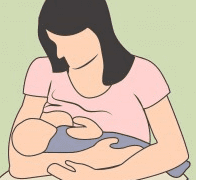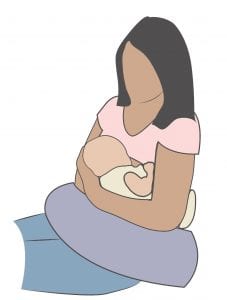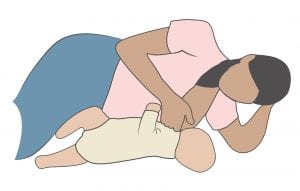Which of These Popular Breastfeeding Positions Are Your Favorite?
Breastfeeding is a time to relax, enjoy and get to know your baby. The right breastfeeding position will help your baby latch easily and correctly for nursing, reduce any nipple pain and help you produce more milk.
Here are a few tips to help you start and sustain nursing; bond with your baby and enjoy this special time of breastfeeding together:
• Support your back and arms with pillows and other soft props so that you’re comfortable, relaxed
• Support your breasts with your hands, as possible, both above and below the nipple
• Support baby’s body fully; their arms and legs should be flexed, relaxed
• Align baby with your body: Baby’s head, shoulders, body, and hips should be aligned facing your body
• Hold and maintain baby’s head higher than their body
• Make sure you can always see baby’s nose, mouth, and face while nursing
• Nurse skin-to-skin with your bodies touching as close as possible
• If you become drowsy or sleepy while nursing, or can’t stay awake to hold baby upright while they snooze after nursing, always place them on their back in a safe, firm crib or bassinet—never on a soft surface like a pillow or a sofa or chair
Sounds easy, right? It all begins with finding the right and best breastfeeding position for you and baby in each circumstance. These nurse-recommended, mom-tested, and baby-approved positions are our top 5:
Cradle Hold (aka Madonna)
 Why we love it: It’s one of the most popular positions and is best used when baby’s at least a few weeks old, has better head control and has more experience latching on to the breast.
Why we love it: It’s one of the most popular positions and is best used when baby’s at least a few weeks old, has better head control and has more experience latching on to the breast.
How to do it:
• Sit upright, with good back & arm support
• Add a pillow under baby to position them right at your breast
• Put one leg on a footstool to help baby’s body face you, and to reduce muscle strain
• Lay baby across your lap, cradling their head in the crook of your arm, with your forearm underneath baby for support
• Baby’s head, body and hips face you
• Guide baby to latch with your other arm
Cross-Cradle Hold (Crossover)


Why we love it: Try this position from birth on, and especially while you can still use both hands to hold baby’s head and support your breast.
How to do it:
• Begin similarly to the Cradle Hold, only use your arm opposite your breast to hold baby so you left arm supports baby at your right breast, and vice versa
• If baby is nursing at your left breast, your right arm holds and supports baby against your body while also guiding their head to your nipple
Football Hold (Clutch)
Why we love it: Moms with cesarean incisions like this position because there’s no strain on your abdomen as you tuck your baby under your arm, on your nursing side, like a football or your favorite purse (remember those!). You also can use both hands to hold and adjust baby’s head while supporting your breast and guiding baby’s latch.
How to do it:
• Sit upright, with good back & arm support
• Place your baby under your arm, face up and toward your side, as if you were carrying a football
• Use your arm on the side from which baby is nursing to support their back and use your hand to support their neck
• Use your other arm to support your breast and help baby latch
• Use pillows or blankets to support baby’s body at the right height for comfortable breastfeeding
Side-Lying Position
Why we love it: This is your go-to position when you’re exhausted, medicated or uncomfortable, such as after cesarean or an episiotomy. Ask your nurse or partner to help you position baby so that you can always see their face and nose while nursing. If you start to feel sleepy, hand baby off to an alert adult or place baby into their crib or bassinet, always on their back only, before you drift off to sleep.
How to do it:
• Lay on your side, placing baby next to you, facing you, with their mouth opposite your breast
• Prop your own head, neck, and shoulder comfortably so that you’re supported during the feeding
• Use your lower arm to snuggle baby close to you, pressing them toward you from their back
• Use your upper arm to support your breast and help baby latch
Laid-Back Breastfeeding
Why we love it: This newer, researched position is gaining popularity. It uses your body to support baby naturally ina comfortable position for both you and baby, which is why some experts call this biological nursing.
How to do it:
• Semi-recline on a sofa or bed, with pillows propped around your body for comfort and support
• Lay baby on your body so that their mouth is at your breast
• Baby should lay so that the natural curves of your body support their weight and position
• You should always be able to see baby’s face and nose while they’re feeding
• Your arms are free to cuddle and relax as baby is naturally positioned at your breast for feeding
Read:


Watch:










Comments are closed.